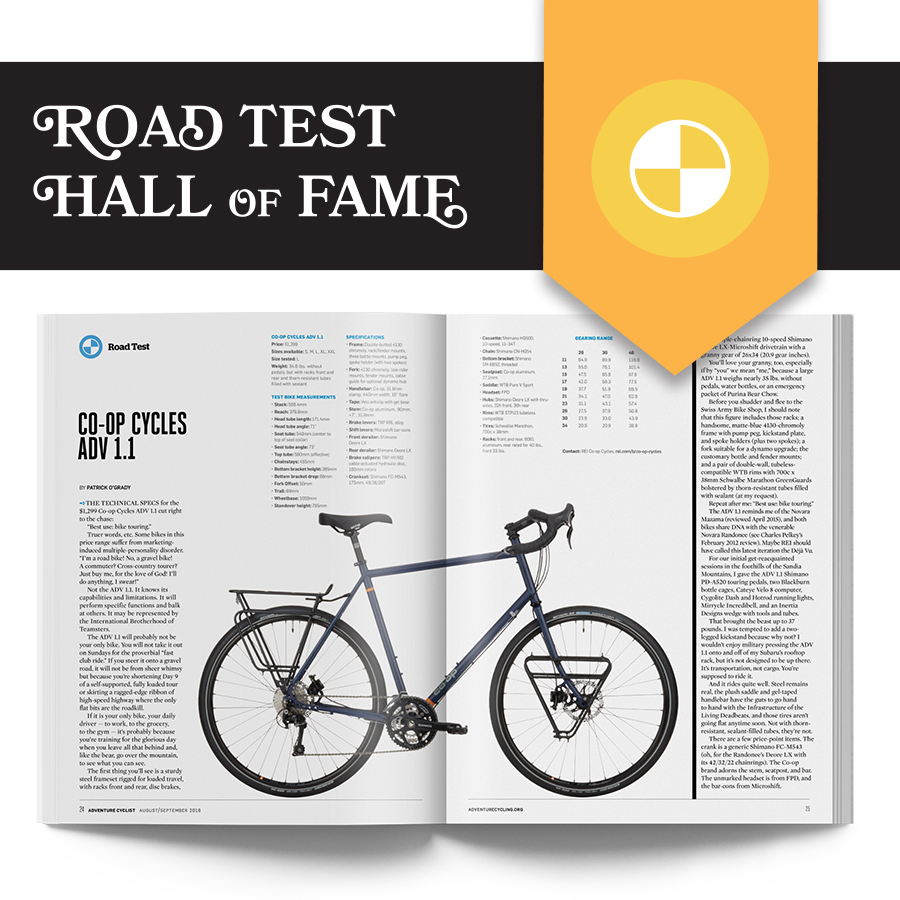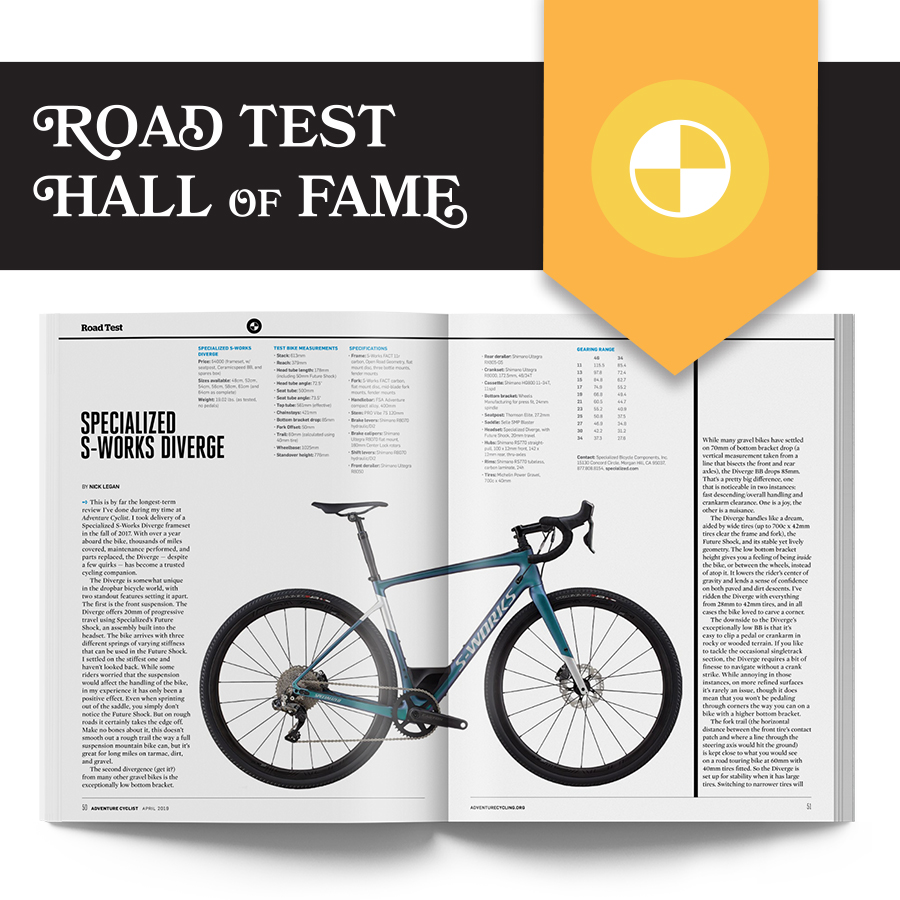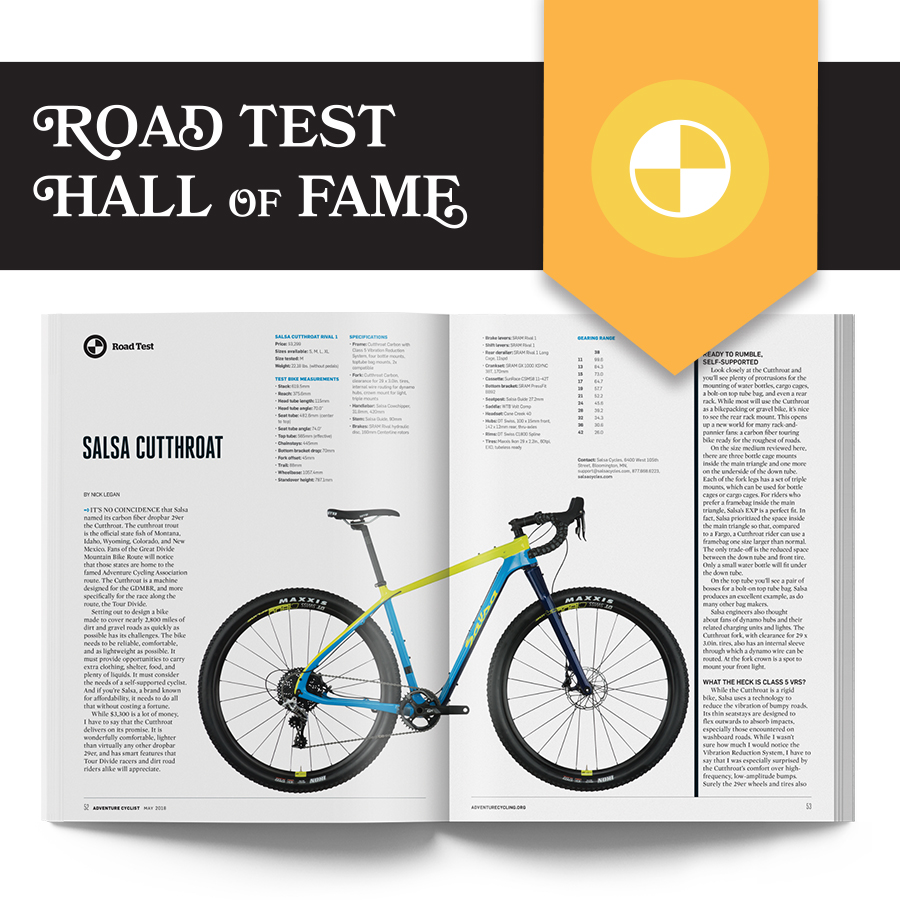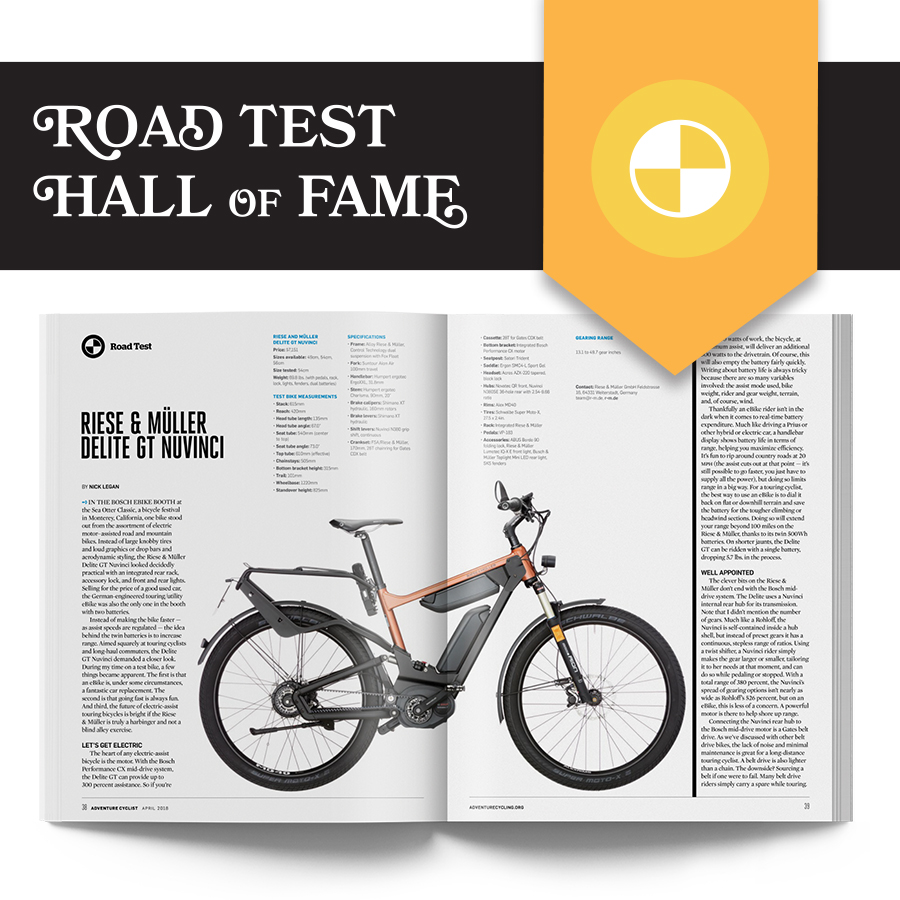Touring Bike Buyers Guide
This article originally appeared as part of the Cyclists Travel Guide in the March 2020 issue of Adventure Cyclist magazine.
If you’re looking for a new touring bike in 2020, you’re in luck — a proliferation of highly capable rides offers options that would have been pure fiction even a few years ago. But with that flood of options comes a head-spinning (and sometimes head-scratching) granularity in bikes called things like X-Road and All-Road and Endurance Road and Adventure and Gravel.
While the naming might be silly, what’s certain is the bike industry has come around to what touring cyclists have known for years: namely, that tire clearance, a little luggage capability, and comfortable geometry make for bikes that do anything and go anywhere. The 23mm tire is nearly dead, and we’re happy to pedal a nice 47mm with room left for fenders right over its grave.
If you’ve been reading Adventure Cyclist for a few years, you know that for the last few “Cyclists Travel Guide” issues, we’ve tackled buying advice in a more theoretical way. We believe that the more cyclists can name their needs and understand the numbers that work for them, the more empowered they are to get the right bike whether that’s with a helping hand from the pros at their local bike shop, a direct-to-consumer order over the internet, or even a parking lot Craigslist transaction. Knowledge is (buying) power.
But with the sheer volume of suitable new bikes available, for 2020 we’re playing it very, very straight. If you’re shopping for a new bike this year, we’ve compiled what we think are some of the very best across a number of categories to suit the dyed-in-the-wool traditionalist, the new-school bikepacker, and even the battery assisted. You might not find the perfect bike for you here, but just like a good bike tour, you’ve got to start somewhere.

Long-Distance Loaded Touring
Rack mounts, triple cranksets, burly steel tubing, and dropbars, that’s the tried-and-true list of ingredients for a round-the-world–capable touring bike. Bolt on some racks, hang four panniers and a handlebar bag, and pedal to the edge of the map.
Full-blown touring bikes don’t see the kind of annual “updates” that iterate other bike categories with a steady stream of incremental (and arguably unnecessary) changes. Generally that means touring bikes have stayed affordable — in some cases, models haven’t changed price for half a decade while enjoying a rising tide of component quality.
But don’t be fooled by a static spec sheet. The recipe for what works when fully loaded still holds up. You can’t go wrong with the trusty pickup truck of the cycling world.
Under $2,000
All the classics fall into this category, proving that the old adage of “fast, cheap, or good — pick two” is a perfect fit for the archetypal touring rig. Spoiler alert: they ain’t fast. What they are is a ton of bike for low- to mid-four figures. Budget an even two grand, and you can walk out of the shop with bike, racks, and bags as ready for the Katy Trail as for Kazakhstan. We’ve reviewed every model here (most more than once) in a long-form Road Test, which you can find at adventurecycling.org/archive.
Fuji Touring
No doubt about what this bike is built for, the Touring is as classic as they come. Sporting rim brakes (Fuji dropped the disc variant last year, but they can probably still be found on showroom floors), a 3×9 drivetrain from Shimano, bar-end shifters, and an included rear rack, this Reynolds-steel–framed option is no-frills and a heckuva bargain for a new bicycle at $900.
Surly Long Haul/Disc Trucker
For 1,350 bucks ($200 more for discs), this is probably the bike you think of when you close your eyes and dream about a long tour. Bosses galore, 3×9 shifting, variable wheel sizes depending on frame size — 26in. for smaller sizes, 700c for bigger — and tubes of Surly’s own 4130 chromoly, the Truckers remain stalwart options not just for their reputation for bombproof reliability, but also for their incredibly wide availability thanks to being owned by distribution giant QBP — most any bike shop in America can order one for you.
Trek 520
Trek’s longest-running model (introduced in 1983) got a big update in 2018, which moved the venerable 520 squarely into the modern age. Unlike the other legs of the touring bike stool from Surly and Fuji, Trek spec’d brifters (combined shifter/brake levers) on the new model while hanging onto the classic 3×9 drivetrain. With disc brakes, included front and rear racks, and the aforementioned brifters, the 520 costs nearly double the Fuji at $1,680 but offers a much more modern package.
Over $2,000
Whether it’s a full-custom dream bike or just a little more of a Gucci build on an otherwise economical frameset, $2,000 can buy quite a lot of bicycle. Of course, it’s not unusual anymore for top-end performance bikes (including touring performance) to crest five figures, so two grand is a relative bargain. But for many, it’s the mark where your non-cycling friends might start scrunching up their noses at the notion.
Jones Plus LWB
Jeff Jones has long preached the gospel of big tires, but his swooping framesets and truss forks were the stuff of dreams for most. Well, even though he’s had more traditional diamond frames and bikes on offer for a few years now, his recent foray into overseas production to bring complete Jones bikes down to the price point of the masses is rapidly spreading the good word. The LWB (long wheel base) can be ordered with big 29 x 2.8in. knobby or smooth tires, features Jones’s own beloved H-Bar, and is ready to go without a wait for just a hair over $2,000.
Co-Motion Deschutes
For essentially the price of a typical frameset from the Eugene, Oregon–based Co-Motion, you can buy the Deschutes as a complete build. The steel frame is still made right there in Oregon, and the paint job is still as deep and glossy as anything from Co-Motion (there’s only one color per year — Ivy Green for 2020), but at a fraction of what you might expect for Made in America. Using road shifters and a super-compact double crankset mated to a mountain bike cassette and rear derailer, if one of the five standard sizes works for you, this might be the best value out there for a traditional touring rig.
Tout Terrain Tanami Xplore
If you want your gears out of the elements, there are two (main) choices for the bicycle traveler: Rohloff’s Speedhub or a Pinion gearbox. Both very German, both with forumfuls of proponents and skeptics. Both pricey. Both, it must be said, very cool. We’ve spent a bit more time aboard Pinions in the last few years and have been impressed by the 12- and 18-speed versions, and that’s what we’d put on a Tanami Xplore from Tout Terrain. It’s going to set you back about five grand depending on spec, but it’s a lifelong bike with Dedacciai steel tubing, integrated rear rack, dynamo power, and a heckuva reliable drivetrain. Prefer Rohloff? The standard Tanami runs just about the same price with gears in the hub.
Curveball
Brompton
How far can you ride a Brompton? We assumed we knew the answer to this question when our time aboard the Lilliputian bike was limited to parking lot loops. Commute to work in the city? Sure. Multiday journeys? Adorable, but no. After a summer putting in some miles though, we’ve seen the light. You’re going to have to pack lightish, but with a little creativity this clever folder will reward the minimalist with the kind of travelability that opens up, well, everything. Plus, if bicycle travel itself invites human interaction, you can safely multiply that by tenfold aboard a Brompton — you will make new friends.

Light Touring
What qualifies as a light touring bike? We have no idea — we’ve seen carbon road bikes with little more than a rain shell and a credit card stuffed into a top tube bag and stylish commuters pulling multiday duty from an overstuffed front basket. In today’s market of adventure and gravel bikes, there is a huge spectrum of bikes for riders who spend the vast majority of their saddle time on day rides but like to tour once or twice a year. Our advice: the vast majority of people will be happier aboard one of these versatile rides than a full-blown touring bike.
Under $2,000
Salsa Journeyman
New in 2018, the Journeyman sloughs off convention as soon as you see it — those fat tubes could only be aluminum. Available in a huge number of configurations in both 700c and 650b wheel sizes (and lots of flat or dropbar builds), the Journeyman family starts at $950 for Shimano Claris and climbs to $1,500 wearing SRAM Apex. Anywhere along the line, though, you’ll find rack and fender mounts, wide-range gearing, good tires from Teravail and WTB, and an incredibly versatile bike that might be aimed at the “entry level” part of the market but would make a huge range of cyclists very happy.
Marin Nicasio
Though Marin has some extremely good (and good-value) bikes in the full-blown loaded touring and bikepacking segments, it’s the Nicasio that anchors the brand’s broad “Beyond Road” bikes. Simple, steel, and smart, the Nicasio starts at 800 bucks with entirely functional if unspectacular parts and trim. The top of the line is more than three times as much, but has a dropper post, hydros, SRAM Rival components, and thru-axles. But you probably don’t need all that and Marin knows it, otherwise why would the low-end Nicasios be so darn good?
Fuji Jari
Fuji’s pricing can make even industry insiders do a double-take. A disc brake–equipped, well, anything, for $700? That doesn’t sound right, and yet the entry-level Jari is just that. The family tops out at a little over two grand, and a carbon prototype was displayed atop a trade show plinth last year, but it’s the two models for less than $1,000 that offer the most intrigue. When asked for a good first bike for the bike travel curious, the Jari is always one of our first suggestions.
GT Grade
Okay, fine, it’s right at $2,000 and we just reviewed it last issue, but bear with us for a second. A carbon bike from a big brand with lowrider mounts and hydraulic discs? Yeah, it’s a screaming deal if you’re in the market for a bike that could propel you to the front of a charity ride or smooth out the miles — and if you don’t think carbon can be smooth, you should look closely at those whippet seatstays — between B&Bs, it’s hard to find a better deal.
Over $2,000
Niner RLT 9 Steel
Best known for going all in on the 29er craze in the mountain bike world more than a decade ago, Niner makes a mighty fine adventure bike in the RLT 9 Steel. There’s a more affordable aluminum version, but with Reynolds 853 tubing, the brand’s full carbon fork with rack and fender mounts, and a plethora of build options, it’s the steel version you want. Race Dirty Kanza and then ride home, wherever that may be. Starting at $2,700 with a Shimano GRX 400 build.
Moots Routt 45
Yeah, fine, we’re projecting here — this is a dream bike (specifically, it’s one of ours). From the perfect welds to the titanium cockpit parts, there isn’t much to dislike about a Moots, except its ability to make your wallet superleggera. With complete builds starting at nearly $8,000, this isn’t the sort of bike you buy twice, but the Steamboat Springs brand wears high-end components, U.S.-made wheels we love from Astral and White Industries, and for a few bucks more (and what’s a few more at this point?) you can have the company’s YBB softtail rear suspension. Plus, it looks like a Moots, which is the nicest compliment we can pay a bike.
Open U.P.
Look around the industry today and you’ll see plenty of bikes with dramatically drooping driveside chainstays to create a compact gravel bike with clearance for a lot of tire. But it was the Swiss wizards at Open who pioneered what’s become a kind of foundational gravel bike in the carbon U.P. Run up to a 2.1in. mountain bike tire or keep things skinny, this is a bike whose reputation outstrips its considerable starting price ($2,900 for the frameset). Whether you knew it or not, this is the gravel bike that deserves a lot of credit for starting the category.
CurveBall
Rodeo Labs Trail Donkey
We’re not entirely sure how to classify this chunky carbon combo from Colorado, but when we saw a fully loaded model roll into Adventure Cycling HQ last summer, we took notice. With a frame that tips the scales at a race-ready three pounds and build options that start with Shimano’s mid-level GRX group and climb from there, this is a Tour Divide race–worthy ride that should be equally at home exploring Forest Service roads on the weekends. Not quite a dropbar mountain bike, not really a gravel racer, and surely not a road machine, the Trail Donkey might not be right for you, but if it is, it’s really right.

Bikepacking
Want to get an argument started? Ask around about the origins of bikepacking. Framebags appeared in Sears & Roebuck catalogs more than 100 years ago, and touring in the vast majority of the world happens on dirt. So is it luggage style or surface or tire size that pushed the needle from “touring” to “bikepacking?” We’re not sure, but for the sake of this buyers guide, these bikes are best suited to off-pavement touring. And for the record, National Geographic editor Noel Grove, who worked with our cofounders on their Hemistour article in the magazine in 1973, seems to have coined the term.
Under $2,000
Salsa Timberjack
“What mountain bike should I buy?” is the question. More often than not, “Salsa Timberjack” is the answer. Great value, modern-but-not-silly geometry, smart spec, and versatility make the Timberjack, and we’re sorry for this in advance, a jack of all trades (really very sorry). The frame is aluminum, which makes sense with 27.5 x 2.8in. tires underneath, and is ready for three water bottles or any assortment of strapped-on bags. Buy the SLX build with 27.5+ wheels for $1,400 (dropper post included) and never look back.
Surly Bridge Club
The redesigned Bridge Club wearing knobby tires (as opposed to the city spec) is another jack of all trades, a king of multiple surfaces, a winner of hearts. Okay, fine, we don’t actually know how to play bridge, but this is an extremely good bike at a great value. For $1,200 you get a platform that’s ready for a trip to the pub or down the Divide. SRAM’s SX Eagle group pushes the benefits of a super wide-range 1x drivetrain even further down the price scale, and the WTB hoops and tires are ready for a lot of surfaces, even if Surly missed the mark by not springing for tubeless-ready rubber from the factory.
Bombtrack Beyond
Sliding in at the price limit, the Beyond is a 29in. wheeled dropbar bikepacking machine in the mold pioneered by the Salsa Cutthroat (see next page) and Fargo. Steel framed, festooned with mounting points, and featuring a SRAM 2×10 drivetrain cribbed straight from mountain bikes of not that long ago, the Beyond is right at home on dirt with tubeless 2.0in. tires from the showroom floor, but a swap to slicks would offer a competent and comfortable on-road touring machine as well. With a rapidly improving distribution network, Bombtracks should be showing up at more shops near you soon.
Over $2,000
Trek 1120
Normally, a laundry list of proprietary parts would send us running for the hills. We want swapability, versatility, uhh, already-in-the-toolbox fixability? The 1120 from Trek is none of that with an alloy frame and carbon fork sporting some very unusual mounts for the bike’s bespoke racks. And while we can see how that might leave you high and dry one day, it’s worth the risk because they’re so smart. Borrowing plenty of cues from the brand’s Stache 29+ line (a favorite of our editor), the 1120 offers a special combination of unloaded performance and firewood-strapping capability for $2,650.
Tumbleweed Prospector
This off-road touring bike was built around a Rohloff from Day One. Owner Daniel Molloy wanted something very specific when he founded Tumbleweed, and he’s got it in the Prospector. It’s offered as a frameset for $1,450, a frameset plus Rohloff kit for $2,700, or a complete build for $4,300. The Tumbleweed is most comfortable wearing 27.5+ rubber and some nice sweeping flat bars like those from Jones or Tumbleweed’s own brand-new Persuaders.
Jamis Dragonslayer
Jamis was out front with the now-common 27.5+ tire size when the brand brought out its Dragonslayer at the 2015 Interbike trade show. Sure, 29+ had shown up here and there, but alongside bikes like Rocky Mountain’s groundbreaking full-suspension Sherpa, it was a harbinger of the trend to come. Lucky for Jamis, a Reynolds 520 steel adventure platform has aged quite well, and the top-spec S1 offers a lot of bike for $2,500, including a SRAM GX Eagle drivetrain and Shimano hydraulic brakes, a favorite spec combo among Adventure Cyclist editors.
CurveBall
Kona Honzo
Sure, there are limitations even soft luggage can’t overcome, but if your ideal bikepacking trip contains a little more shred than bed, the Honzo is the bike for you. A 29er hardtail (available in steel, alloy, and carbon versions) with progressive geometry and components tuned toward the pure mountain biking end of the spectrum, the Honzo and bikes like it (Ibis DV9, Santa Cruz Chameleon, and Diamondback Sync’r Carbon) offer a one-bike solution to the mountain biker who wants to do some overnights and maybe a bit more.

Recumbent, Tandem, eBike
How can you find the right touring bicycle if you’re not looking for a bicycle at all — perhaps a recumbent trike is in your future? Or maybe your bike tastes trend toward the tandem? Are you looking for a “tailwind on demand” to match speeds with a touring partner or just want to get a lift so you can arrive each night a little less spent? You’re in luck because the Golden Age of Touring Bikes extends beyond the traditional. Anecdotally, the recumbent trike market is exploding (and laid-back two-wheelers remain popular), e-assist technology well suited for bicycle travel has arrived in every category, and a range of price points, styles, and configurations are available to suit pretty much anyone. Never tried a recumbent or an eBike? The odds have never been better that there’s a dealer stocking some near you.
Under $2,000
Catrike Eola
A recumbent tadpole trike has a few advantages when it comes to manufacturing — namely, the adjustable boom means you only need one frame size — but Catrike’s ability to make a $2,000 trike in the U.S. is still an achievement. The Florida-based brand has long been known for speed and quality, but with the Eola’s launch last year, they offer an entry price point too. With 20in. wheels, a 1x drivetrain, and BB7 brakes, its spec should look somewhat familiar to the touring cyclist, even if the gear range is a little on the high side for heavy loads. Still, if you’re on the fence and value domestic production, the Eola gets a long look.
Aventon Pace 500
We haven’t ridden the Aventon, but it’s slim pickings for eBikes under two grand and the non-assisted Aventons we’ve seen have impressed with their quality for the dollar. You only get an advertised range of 30 miles at this price, so plan accordingly, but if you’re looking for a commuter and a little boost to hit overnight escape velocity, the Pace 500’s rack mounts and upright commuter-style geometry should allow you to dip a toe into the electrified world without breaking the bank.
KHS Milano
Yeah, it’s $2,100, but you try to find a reputable tandem under two grand. (Seriously, give it a try, and let us know if you succeed!) As you’d expect in a bicycle built for two, tandems command a higher price than a comparable single, which is why KHS’s Milano offers an intriguing entry point. Made from aluminum and sporting a triple drivetrain, the KHS can take racks and fenders, features disc brakes with monster 203mm rotors to slow things down, and could easily be geared a little lower for heavier loads. And while KHS might not be known for their graphics, they are known for great alloy frames at a great price.
Over $2,000
Cruzbike Q45
The suspended Q45 from Cruzbike is going to get some questions — the brand’s front-wheel drivetrain doesn’t look like anything most cyclists have ever seen. But that unique drivetrain configuration is what gives Cruzbikes their reputation as excellent climbers by offering more leverage than you might get on other recumbents. Throw on the available rear rack and put the 26 x 1.75in. tires on the tarmac. A benefit of the Cruzbike design is (relatively) easy packability, thanks to the fact that half the frame is effectively a swingarm.
TerraTrike Rambler E.V.O.
Electric assist continues to trickle into more and more models of all kinds of machines, but TerraTrike’s Rambler E.V.O. was one of the first when we reviewed it in 2017. The current model features a Bosch motor mounted in the “bottom” bracket at the crankset. With a 400 watt-hour (Wh) battery, the Rambler E.V.O. essentially matches one of the most common configurations in the eBike world today and should be good for reasonable touring range (though longer trips will still necessitate a spare) and provide excellent reliability. It’s not cheap at $4,500, but if you’re looking for industry standard e-assist on a trike, this is it.
daVinci Designs Tailwinds
Riders looking for a unique pedaling experience together have long sought daVinci Designs bikes for their ability to coast independently. With the addition of a Shimano STEPS E8000 electric motor, the Tailwinds suddenly becomes a sort of ultimate tandem touring machine. The folks at daVinci tell us that the demand for electric assistance is skyrocketing and the $9,000 price tag isn’t a deterrent — after all, it’s two bikes in one!
Curveball
HASE Pino
Is it a tandem or a recumbent — or a recumbent tandem? All three, and none of them, the recumbent/upright combo offered by the HASE Pino line is a unique configuration (fans of Bilenky will recognize it) that’s just right for some. By placing the riders’ heads close to one another, conversation is easy, and no one’s view is obstructed. We’ve never ridden one and have a few questions about handling and weight distribution when fully loaded, but for the right tandem pair, there’s not much else like it.
Tern GSD
Okay, one more. The Tern “Get Stuff Done” uses the same twin-battery approach to dealing with range that Riese & Müller favor, but the GSD is a bike built for utility. Load up the kids, the groceries, the firewood, whatever, top off the batteries (400 and 500Wh, respectively), and you’re rolling for up to 150 miles. Or max out this 20in. wheeled cargo bike’s 400 lbs. capacity, pop it into turbo mode, and wonder why you ever needed a car.

